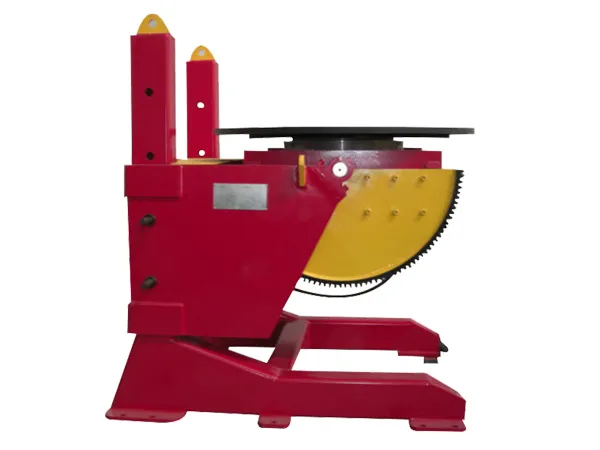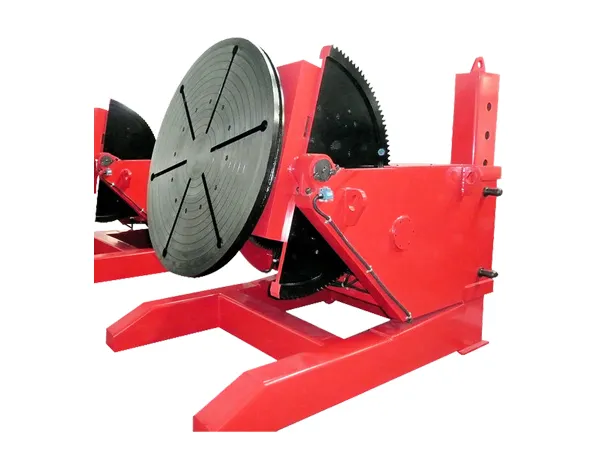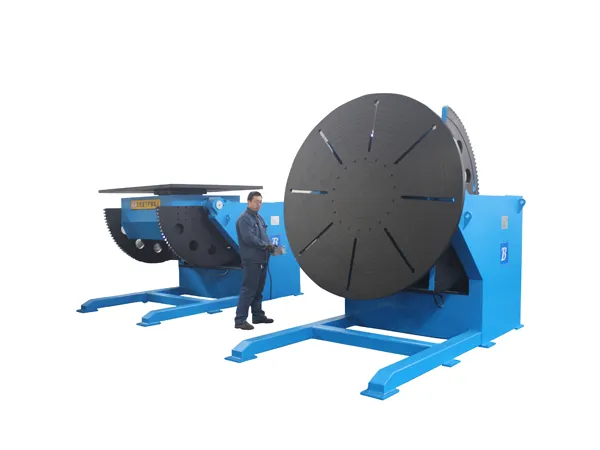A welding positioner is a mechanical device used to manipulate and hold a workpiece in the optimal position for welding. It allows welders to work more efficiently by rotating or tilting the workpiece to the desired angle, making it easier to access different areas for welding without having to reposition themselves constantly.
Welding positioners come in various shapes and sizes, ranging from small tabletop units for light-duty welding to large, heavy-duty units capable of handling massive workpieces in industrial settings. They typically consist of a base, a rotating mechanism, and a fixture to hold the workpiece securely in place. Some advanced positioners may also include tilting capabilities to achieve even more precise positioning.
Using a welding positioner can improve weld quality, increase productivity, and reduce fatigue for the welder by providing better access to the welding area and allowing for consistent weld bead placement.

Horizontal Positioners: These positioners rotate the workpiece around a horizontal axis. They are often used for welding cylindrical or round workpieces such as pipes, tanks, and vessels.
Vertical Positioners: These positioners rotate the workpiece around a vertical axis. They are suitable for welding flat or plate-like workpieces and are commonly used in industries such as shipbuilding and construction.
Headstock-Tailstock Positioners: These positioners consist of a headstock (which holds one end of the workpiece) and a tailstock (which supports the other end). They allow for rotation and tilting of the workpiece, providing greater flexibility in positioning during welding.
Turntable Positioners: Turntable positioners are like rotating platforms that can hold and rotate the workpiece. They are often used for smaller workpieces and in situations where precise rotation is required.
Manipulators: Manipulators are more complex positioners that combine vertical and horizontal movement capabilities. They can move the welding torch in multiple directions around the workpiece, allowing for welding in various positions and angles.
Automatic Welding Positioners: These positioners are equipped with automation features such as programmable controls, sensors, and robotic arms. They are used in automated welding processes where precise control and repeatability are essential.

Base: The positioner typically has a sturdy base that provides stability and support for the entire device.
Rotation Mechanism: A motorized rotation mechanism is usually present to rotate the workpiece. This rotation allows the welder to access different sides of the workpiece without needing to reposition themselves, thereby reducing the need for manual handling and minimizing downtime.
Tilt Mechanism: Some welding positioners also incorporate a tilting mechanism that allows the workpiece to be tilted to various angles. This feature is particularly useful for welding workpieces with complex geometries or for achieving specific welding angles.
Control System: Modern welding positioners are often equipped with a control system that allows precise control over the rotation and tilt functions. This control system may include buttons, switches, or a digital interface for the operator to input parameters such as rotation speed, tilt angle, and direction of rotation.
Safety Features: Safety is a critical aspect of welding positioners. They may include features such as emergency stop buttons, overload protection, and interlocks to prevent accidental injuries or damage to the equipment.
The working process of a welding positioner involves the operator placing the workpiece on the positioner's platform and adjusting its position and orientation using the rotation and tilt mechanisms. Once the workpiece is properly positioned, the welding process can be carried out with greater efficiency and accuracy. The operator can control the rotation and tilt of the workpiece as needed to access different welding areas without having to manually reposition the workpiece or themselves.

Preparation: Before using the welding positioner, the welder sets up the workpiece and secures it onto the positioner's chuck or fixture.
Adjustment: The operator adjusts the welding positioner settings according to the required orientation for the welding process. This may involve adjusting the rotation speed, tilt angle, or other parameters depending on the specific welding job.
Control Panel: Most welding positioners come with a control panel where the operator can input commands to control the movement and positioning of the workpiece. These controls may include buttons, switches, or digital interfaces for precise adjustments.
Rotation: The positioner can rotate the workpiece horizontally, vertically, or both, depending on its design. This rotation capability allows the welder to access different angles of the workpiece without having to reposition themselves manually.
Tilt: Some welding positioners also have the ability to tilt the workpiece at various angles, providing even greater flexibility for accessing hard-to-reach areas during welding.
Safety Measures: Operators should adhere to safety protocols when using welding positioners, including wearing appropriate protective gear such as gloves, helmets, and goggles. They should also ensure that the workpiece is securely fastened to prevent accidents or damage during rotation or tilting.
Monitoring: Throughout the welding process, the operator monitors the positioner and the welding operation to ensure that everything proceeds smoothly. They may need to make adjustments to the positioner settings as needed to achieve the desired weld quality.
Shutdown: After completing the welding process, the operator shuts down the welding positioner according to manufacturer instructions. This may involve stopping the rotation or tilting mechanisms and powering off the control panel.
Overall, welding positioners enhance productivity and quality in welding operations by providing precise control over the orientation of the workpiece, allowing welders to work more efficiently and effectively.
No. 1 Intersection of Chuangye Avenue and Weilai Avenue,
Yiyang County,Luoyang City, Henan Province, China
+86 400-0379-069
Copyright © 2023 An Automated Welding and Cutting Equipment Manufacturer Focusing on Welding Column Boom and Welding Rotator | All Rights Reserved Technical support: ShangXian